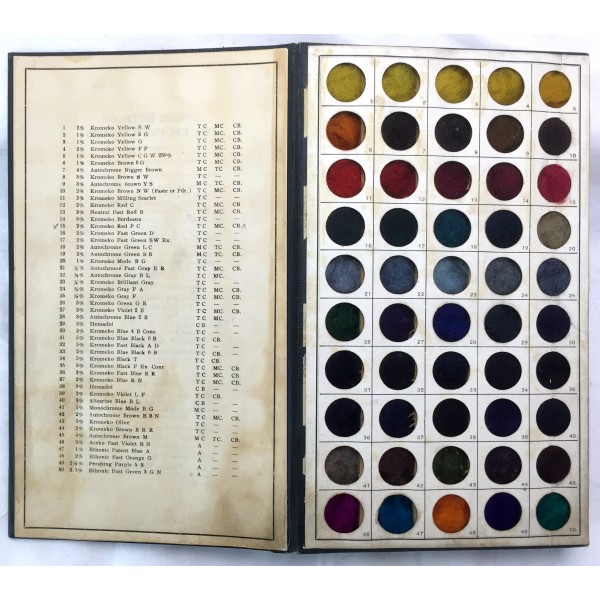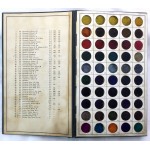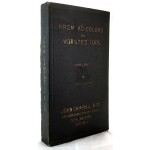Kromeko Colors on Worsted Tops
Kromeko Colors on Worsted Tops: Camel Dyes
John Campbell & Co. American Dystefuff Manufacturers
New York: John Campbell & Co., 1915.
Trade catalog. Tall gilt-lettered blue cloth box. 50 vividly colored dyed wool samples. Housed in divided box, with accompanying descriptive sheet.
"The outbreak of World War I resulted in the cessation of dye imports from Germany. It became critical to manufacture intermediates and dyes in the U.S. Three separate concerns, all under the chairmanship of George H. Whaley, the principal stockholder, were organized. John Campbell Co. was the selling company. The manufacturing company was the Amalgamated Dyestuffs & Chemical Works, Inc. located in Newark, New Jersey. The plant site was located at Plum Point Lane and Avenue P in Newark. The property was four acres in size and served by a railroad siding. Production of naphthols began on a small scale in 1915. Then sulfur and azo dyes were introduced. Textile processing chemicals, or dyeing assistants, were also made...John Campbell & Co., New York World War I Dyestuff ManufacturererColorantsHistory. Org John Campbell & Co. Dyestuff Plant in Newark, New Jersey ca. 1920Photo Courtesy of D. Pizzoferrato In 1876 John Campbell came from England and established a dyestuffs importing business in New York City that was known as John Campbell & Co. The offices were located at 75 Hudson Street. Campbell imported dyes up to the time of his death in 1905. In1907 the company was incorporated and continued to import dyes until 1914.The outbreak of World War I resulted in the cessation of dye imports from Germany. It became critical to manufacture intermediates and dyes in the U.S. Three separate concerns, all under the chairmanship of George H. Whaley, the principal stockholder, were organized. John Campbell Co. was the selling company. The manufacturing company was the Amalgamated Dyestuffs & Chemical Works, Inc. located in Newark, New Jersey. The third company was the Republic Chemical Works in Reading,Pennsylvania which manufactured intermediates.Amalgamated Dye stuffs & Chemical Works was incorporated in New York with capital of $50,000. The company was founded by George H. Whaley, Charles H. Jones, and Emile H. Kick, all of Jersey City. The plant site was located at Plum Point Lane and Avenue P in Newark. The property was four acres in size and served by a railroad siding. Production of naphthols began on a small scale in 1915. Then sulfur and azo dyes were introduced. Textile processing chemicals, or dyeing assistants, were also made. In 1918-1919, the company built a one-story, 50 by 90 foot building at a cost of$8,500. The plant expanded over time to twenty chemical buildings with an area of 105,000 square feet. A range of about 50 different dyes was eventually manufactured and sold under the trade name "Camel Dyes". During World War I the company argued that American-made dyes should be given names of their own and not those coined by German producers before the war. This was clearly stated in a company pamphlet published in 1918:"Every American manufacturer of dyestuffs should give to his colors an appropriate name. We should get away from the habit of referring to American colors by foreign names. In a comparatively short time we have produced colors that are equal to, and in many instances better than, the so-called German standards. It is only a question of time when the fastest, rarest, and most intricate dyes will be produced in this country.Now the American consumer will never willingly put himself in the position he occupied before the war shut off the supply of German colors. He realizes the necessity of having a dependable source of supply at home, and the only way this can be done is for the consumer of dyes to support the American Dyestuff Manufacturer. No American mill man should use the German trade words for the names by which he has known colors in the past. To do so would be playing right into the hands of the German business propagandist. Therefore, let us be loyal to everything American, and among other things designate the American colors by their American names."
Colorants History, 2008.


